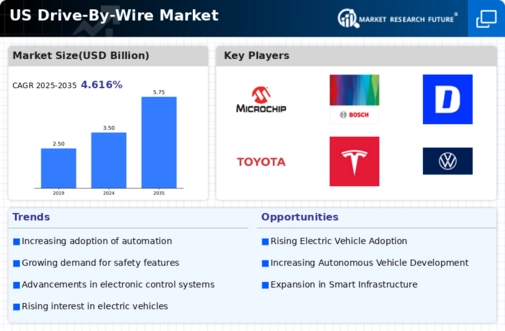Cost Efficiency in Manufacturing
The drive by-wire market is witnessing a shift towards cost-efficient manufacturing processes. By replacing traditional mechanical systems with electronic controls, manufacturers can reduce production costs and improve assembly line efficiency. The integration of drive by-wire technology can lead to a reduction in vehicle weight, which in turn enhances fuel efficiency. Reports indicate that automakers can save approximately 15% in production costs by adopting drive by-wire systems. This cost efficiency is particularly appealing in a competitive market where profit margins are under pressure. As manufacturers seek to optimize their operations, the drive by-wire market is likely to benefit from increased adoption rates, as companies aim to balance quality with affordability.
Increased Demand for Safety Features
The drive by-wire market is experiencing heightened demand for advanced safety features in vehicles. As consumers become more safety-conscious, manufacturers are integrating drive by-wire systems to enhance vehicle control and responsiveness. This technology allows for quicker reaction times in critical situations, potentially reducing accident rates. According to recent data, vehicles equipped with drive by-wire systems can improve safety ratings by up to 30%. This trend is likely to drive investments in research and development, as automakers strive to meet consumer expectations and regulatory standards. Furthermore, the increasing prevalence of autonomous driving technologies is expected to further propel the adoption of drive by-wire systems, as they are essential for the seamless operation of self-driving vehicles.
Integration with Smart Infrastructure
The drive by-wire market is poised for growth due to the increasing integration of vehicles with smart infrastructure. As cities evolve towards smart mobility solutions, the demand for vehicles that can communicate with traffic management systems is rising. Drive by-wire technology is essential for enabling this connectivity, allowing vehicles to respond dynamically to real-time traffic conditions. This integration can enhance traffic flow and reduce congestion, which is a growing concern in urban areas. Market forecasts suggest that the adoption of smart infrastructure could lead to a 15% increase in the demand for drive by-wire systems over the next five years. As urban planners and automakers collaborate on smart city initiatives, the drive by-wire market is likely to benefit from this trend.
Consumer Preference for Advanced Features
The drive by-wire market is significantly influenced by changing consumer preferences towards advanced vehicle features. Modern consumers are increasingly seeking vehicles that offer enhanced connectivity, automation, and user-friendly interfaces. Drive by-wire systems facilitate these advanced functionalities, allowing for features such as adaptive cruise control and lane-keeping assistance. Market analysis suggests that vehicles equipped with such features are likely to see a sales increase of up to 25% compared to traditional models. This consumer shift is prompting manufacturers to invest in drive by-wire technology, as they aim to meet the evolving expectations of tech-savvy buyers. Consequently, the drive by-wire market is poised for growth as automakers respond to these demands.
Environmental Regulations and Sustainability
The drive by-wire market is increasingly shaped by stringent environmental regulations aimed at reducing emissions and promoting sustainability. As governments implement policies to combat climate change, there is a growing emphasis on electric and hybrid vehicles, which often utilize drive by-wire technology. This shift is evident in the automotive sector, where manufacturers are required to meet specific emissions targets. The drive by-wire systems contribute to improved energy efficiency, making vehicles more compliant with these regulations. Data indicates that vehicles utilizing drive by-wire technology can achieve up to 20% better fuel economy. As regulatory pressures mount, the drive by-wire market is likely to expand, driven by the need for compliance and the push for greener alternatives.






















Leave a Comment